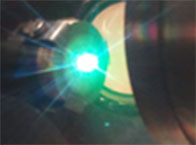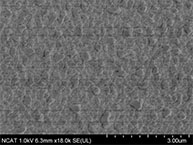North Carolina REVT Teacher Takes Nano Research Back to Classroom
Outcome/accomplishment: Beginning October 2012, a military veteran teacher has been engaging in nanomaterials research in the ERC for Revolutionizing Metallic Biomaterials (RMB) at North Carolina A&T State University (NCAT) in Greensboro, NC. Mr. Eric Craven is a 6th grade science and math teacher at Kernodle Middle School, an ERC-RMB partner school in Greensboro. Under the guidance of RMB faculty Dr. Dhananjay Kumar, Craven has been working evenings in the ERC labs after his school duties on a nanofabrication process called pulsed laser deposition (PLD). The ERC full-time researchers and students have been working on generating titanium and titanium nitride nanowires and coatings. Mr. Craven is carving out a new related research area for himself – working with Dr. Kumar’s graduate student on developing and perfecting a protocol for making silver thin films and nanowires.
 REVT Eric Craven in ERC-RMB lab
|
 Pulsed laser deposition process
|
 Silver nanofilm deposited by Craven
|
- Professional development of military veteran: Says Craven, “I’m always trying to grow in my professional and personal knowledge – this opportunity gives me new knowledge in a field that is so different from my prior experiences.”
- ~100 6th grade students annually: Says Craven, “I am emphasizing to my 100 sixth graders about how scientists’ experiments often fail, but that we learn just as much or more from those failures as our successes. The true value of experimentation is to step over the ashes of our failures towards planning for the next steps to take.”
- Leveraging NUE: The broader impacts of a concurrent NSF Nanotechnology Undergraduate Education (NUE) grant led by NCAT Profs. Bhattarai and Kumar are being leveraged by the attendance of the REVT.
- Leveraging ERC-RMB: The year-round research involvement allowed by the ERC’s REVT supplement allow for deeper involvement of the military veteran as compared to other ERC-RMB RET participants, who only work for a 6-week summer duration. Mr. Craven’s positive experience has encouraged two of his science and math teaching colleagues to apply (and get accepted) to RMB’s Summer 2013 RET program. They are looking forward to working together on module development for deployment at their school in the coming academic year.

